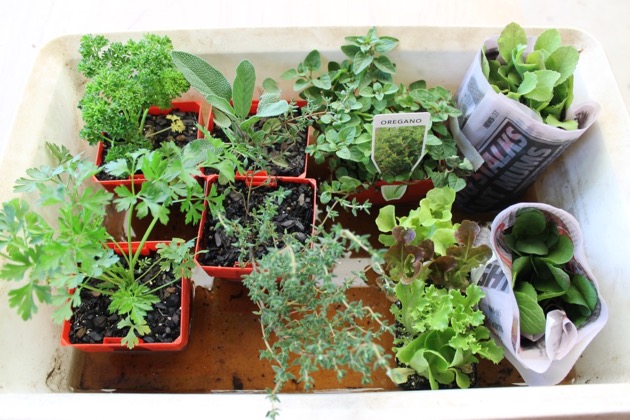April, week 3 in The Simple Home
By now you have probably had enough time to think about what you want to plant and where it will grow and hopefully you've gathered a few containers and some growing mix. Depending on what you're hoping to grow, you might also have a trellis or bamboo and string and you might have thought about fertiliser and a few tools. I hope you find second hand items and can keep your setup costs as low as possible because gardening can become expensive and it doesn't have to be.
Containers and potting mix
Types of containers
Look around your home, garden and garage, as well as your local recycle centre, to
see if you have any suitable containers. Most of them need to be big. If you restrict the root growth of what you’re growing, it will also restrict
your crops, so large containers are better than small ones. Of course you can grow a few herbs in small containers, or plant then around the edge of larger containers. Look for old rubber tubs, an old slightly rusty wheelbarrow, boxes made from untreated
wood, polystyrene troughs or metal containers. Most of the recycled containers
won’t last a long time because they’ll be sitting in the sun all year long. But
that doesn’t matter. You can change containers when you change seasons and
start planting again. Keep that in mind and as you go through the year keep an open eye for follow-up containers. And if you have any good ideas for containers that you're using at home, share them with us here.
If you don’t have anything to recycle buy a few of those coloured plastic/rubber
flexi-tubs. They range in size from 15 to 60 litres. If you need
something bigger than that, use grow bags. In the last Simple Home post there is a link to a YouTube video on how to make grow bags.
This is a long pot full of cos/romaine lettuce I grew last year during summer. I kept the pot in the bush house and we had fresh lettuce most of the summer.
What do you fill your
containers with?
Potting soil and garden soil are very
different. Potting soil is a free-draining light mix that will support the growth
of roots in a container while allowing water to drain away. Garden soil
contains microbes and minerals that you want for your vegetables, but it
doesn’t drain well. Plants will suffocate if there is always water around their
roots. There is no doubt about it; you’ll need to buy potting mix if you’re
going to plant your garden in containers.
If you're in Australia, look for the red label on the potting mix you buy.
REMEMBER: Fill your large containers where they’ll grow so you don't have to move heavy pots around. You can move the potting mix around in a wheelbarrow. And don’t forget to add perlite if container weight is an issue.
You can buy good potting mix in 25 litre or
65 litre bags but if you’re going to use a lot of mix, it will probably be
cheaper to get a quote from a local supplier of bulk potting mix. They usually
supply loads of half a metre or one metre which will work out cheaper than
buying the same amount of bagged mix.
There are two things to remember though: go to the supplier’s yard, look
at the quality of the mix and ask if they mix it to the Australian Standard (or your country's standard).
You don’t want potting mix full of pine bark or sand. The second thing is that
you’ll have to be home when the delivery is made because it will be dumped
where you tell the driver to leave it and you’ll have to deal with it fairly
promptly. So either use it, put it in bins, or cover it with a tarp as soon as it's delivered.
It will wash away if it’s sitting in the open and you have a storm.
Reusing potting mix
At the end of the season, your potting soil
will probably hold a few roots and will have lost many of its nutrients. You
can replace the nutrients and remove the roots and use the mix again for the coming season.
Additives for the spent potting mix include,
very old cow, stable or sheep manure, good compost, worm castings, perlite, a small addition of garden soil or mix the old and new potting mix together with some manure.
Setting up your trellises
Many of your container plants will do very
well indeed without any extra support, or with a single bamboo stake to anchor
the plant. Other plants need more elaborate support structures. Vine vegetables
such as cucumbers, climbing beans and tall tomatoes need a trellis or
a tripod. If you can give the plant a good trellis to grow on, you’ll be
rewarded with abundant vegetables.
If you have tall plants or want to grow peas, beans, cucumbers etc., you may be able to attach your trellis or some light reinforcing metal mesh to a wall. Have a good look around home and use what you have, or look in the recycle centre. If you have shade cloth or weed mat and a sewing machine, think about making a vertical wall hanger for your herbs. Have a look at this one.
In our last container garden post next week, we'll talk about how to make compost as well as the all important watering and fertilising.








